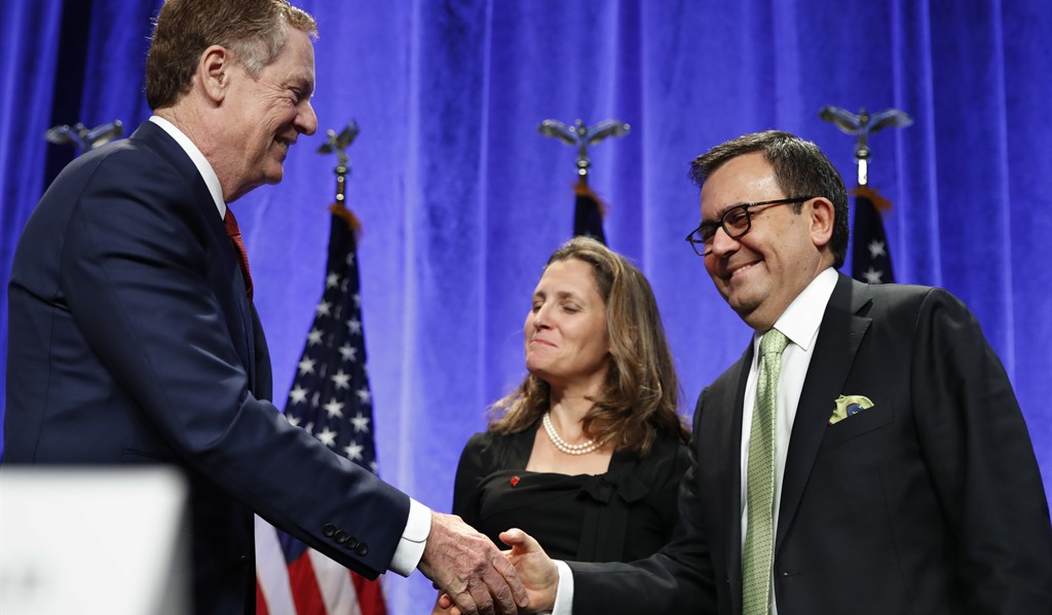It depends on who you ask, how you count … and why. The Trump administration wants to force Mexico and Canada into significant concessions in NAFTA renegotiation talks, and its representative took a hard line in his opening remarks:
“We cannot ignore the huge trade deficits, the lost manufacturing jobs, the businesses that have closed or moved, because of incentives, intended or not, in the current agreement,” U.S. Trade Representative Robert Lighthizer said. “The U.S. government has certified that at least 700,000 Americans have lost their jobs due to changing trade flows resulting from NAFTA.”
Lighthizer cautioned: “I want to be clear that [Trump] is not interested in a mere tweaking of a few provisions and a couple of updated chapters. We feel that NAFTA has fundamentally failed many, many Americans and needs major improvement.”
Much of this is for domestic consumption, too — and not just among Trump’s core base of voters, many of whom perceive themselves as winding up on the losing end of NAFTA. They’re not alone, either, and that has implications for renegotiations. Labor unions had to swallow hard and let Bill Clinton off the hook for NAFTA in 1994, but they have no such incentives for Trump in 2017.
At the end of this process, the Senate will have to ratify the renegotiated treaty, and that requires two-thirds of the Senate. Republicans will have to find at least 15 Democrats to play along, and unless the labor unions get what they want out of NAFTA, they’d be lucky to get Joe Manchin and Heidi Heitkamp. Lighthizer needs to lay down the law early, and hope to frame whatever comes out as the best deal possible, in order to get Richard Trumka and other labor leaders to play along.
With that in mind, Lighthizer intends this opening statement to shape the rhetorical battlefield, and to set expectations in such a way as to make the end result look as attractive as possible. Accuracy isn’t really the point, but it’s still worth investigating. Glenn Kessler dismantles the argument pretty effectively in his fact-check today, giving Lighthizer four Pinocchios in part for claiming that these figures were “certified”:
USTR is only counting job losses — and ignoring any possible job gains from the rise in U.S. exports to Mexico and Canada. The Commerce Department estimates that every $1 billion in exports in goods supports 5,300 jobs, which roughly translates into an additional 1.8 million jobs in the United States from the increase in trade with Mexico and Canada since 1994, even before calculating the impact from trade in services.
As we have noted before, most mainstream economists do not believe the number of jobs is significantly affected by trade policy; instead, trade changes the mix of jobs. That obviously creates winners and losers, but Trump’s USTR is only focusing on the losers, which the official acknowledged. “The data reference was not an assessment of net gains or losses, but focused on the number of Americans who were certified by the Department of Labor as losing their jobs due to NAFTA,” the official said, adding that Lighthizer did note that “many Americans have benefited from NAFTA,” including in the agriculture and services sectors.
The nonpartisan Congressional Research Service has closely examined NAFTA and concluded that “overall net effect of NAFTA on the U.S. economy has been relatively small.” The report noted that “U.S. trade with Mexico and Canada was already growing before NAFTA and it likely would have continued to do so without an agreement.” Moreover, it is difficult to isolate the actual impact of NAFTA from other economic effects that impact job creation and job loss. …
To recap, Lighthizer touted a statistic derived from fuzzy data that was 16 years old — and which ignored the positive impact of trade with Mexico and Canada. In doing so, he sidesteps the fact that most economists believe the impact of NAFTA on the U.S. economy was relatively modest and trade imbalances are relatively small, especially if oil products are excluded. His figure is offered without context and thus is rather misleading. Lighthizer pushed this into Four-Pinocchio territory by stating such a misleading number was “certified” by the U.S. government and could well be “much, much bigger.” In doing so, he suggests this fanciful bit of spin was vetted by government experts.
In other words, it is not altogether unlike static tax analysis and its disconnection from the full impacts of tax cuts, only this time in hindsight. The 700K number only referred to a relatively short period of time, and only to gross losses rather than the net effect. It’s akin to claiming that a tax cut will “cost” five trillion dollars from revenue without accounting for the stimulus effect it will have on other revenues.
Keep that in mind when it comes to the arguments surrounding the renegotiated NAFTA. It won’t be the last time that tactic gets deployed, by both its opponents and supporters.








Join the conversation as a VIP Member